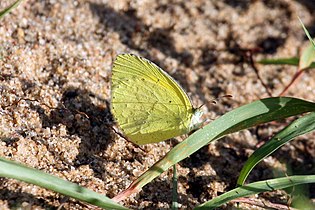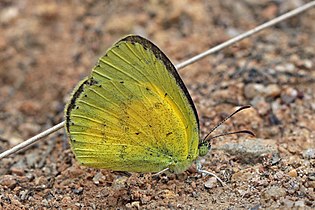Eurema brigitta
| Small grass yellow | |
|---|---|

| |

| |
| Imago (above) and final instars (below) | |
| Scientific classification | |
| Domain: | Eukaryota |
| Kingdom: | Animalia |
| Phylum: | Arthropoda |
| Class: | Insecta |
| Order: | Lepidoptera |
| Family: | Pieridae |
| Genus: | Eurema |
| Species: | E. brigitta
|
| Binomial name | |
| Eurema brigitta (Cramer, 1780)
| |
| Synonyms | |
| |
Eurema brigitta, the small grass yellow[4][5] or broad-bordered grass yellow, is a small butterfly of the family Pieridae, that is, the yellows and whites. It is found in India, other parts of Asia, Australia and Africa.[4][5][3][2]
Description[edit]
Wet-season form: Male. Upper-side somewhat paler yellow. Fore-wing with the outer marginal black band; the apical edge of costa and the cilia rosy-red. Hind-wing with the black outer band somewhat narrower, macular, the decreasing portions each with a more prolonged inner-tooth, and the yellow ground-colour between each extending to the outer edge. Underside pale yellow, the fore-wing also having a very slightly defined sub-apical inwardly-oblique squamous streak. Fore-wing with the entire costal edge and outer marginal cilia, and also the outer marginal cilia of the hind-wing, rosy-red. Female. Upper-side. Apical edge between the subcostals of fore-wing, and cilia of both wings paler rosy-red. Underside with the markings on hind-wing slightly visible. Fore-wing above with the black outer band broken beneath the lower median veinlet. Hind-wing with the outer band similar to male, its portions slightly broader. Underside similar to male, the markings being slightly more defined.
Intermediate form: Male. Upper-side. Fore-wing with the outer band slightly narrower than in wet form; cilia paler red. Hind-wing with the marginal macular band narrower, and composed of smaller portions. Underside similar to wet form. Female. Upperside. Fore-wing with the outer band less broken at its posterior end than in wet form. Hind-wing with the marginal macular band less distinct and narrower. Underside similar to the male.
Dry-season form: Both sexes much smaller than in intermediate form. Cilia paler. Male. Fore-wing above with the inner-edge of the marginal band less sinuated than in intermediate form, its posterior end indistinctly broken. Hind-wing with the lower portions of the macular band somewhat larger and less dentate. Underside. Both wings with less defined markings than in intermediate form. Female. Upper-side. Fore-wing with the band slightly broken at posterior end. Hind-wing with the lower portions of band somewhat wider. Underside with the markings indistinct.
The wingspan is 30–35 mm. Adults are on the wing year-round.[6]
Food plants[edit]
The larvae feed on Hypericum aethiopicum and Chamaecrista mimosoides.[6]
Subspecies[edit]
- E. b. brigitta – tropical Africa
- E. b. pulchella (Boisduval, 1833) – Madagascar, Mauritius, Comoro Islands, Aldabra Islands
- E. b. drona (Horsfield, [1829]) – Sumatra, Java to Lombok
- E. b. senna (C.&R.Felder, [1865]) – Peninsular Malaya, Singapore, Indochina
- E. b. fruhstorferi (Moore, 1906) – eastern Indo-China
- E. b. ina Eliot, 1956 – southern Sulawesi
- E. b. hainana (Moore, 1878) – Hainan
- E. b. rubella (Wallace, 1867) – Sri Lanka, India, Burma to southern China, Nicobars
- E. b. formosana Matsumura, 1919 – Taiwan
- E. b. yunnana (Mell)
- E. b. australis (Wallace, 1867) – Australia, New Guinea, Papua New Guinea
Gallery[edit]
-
E. b. brigitta, KwaZulu-Natal, South Africa
-
E. b. pulchella, Madagascar
See also[edit]
References[edit]
- ^ Westrip, J.R.S. (2021). "Eurema brigitta". IUCN Red List of Threatened Species. 2021: e.T159946A165246239. doi:10.2305/IUCN.UK.2021-1.RLTS.T159946A165246239.en. Retrieved 10 March 2022.
- ^ a b c
 One or more of the preceding sentences incorporates text from this source, which is in the public domain: Swinhoe, Charles (1905–1910). Lepidoptera Indica. Vol. VII. London: Lovell Reeve and Co. pp. 38–40.
One or more of the preceding sentences incorporates text from this source, which is in the public domain: Swinhoe, Charles (1905–1910). Lepidoptera Indica. Vol. VII. London: Lovell Reeve and Co. pp. 38–40.
- ^ a b
 One or more of the preceding sentences incorporates text from this source, which is in the public domain: Bingham, C.T. (1907). The Fauna of British India, Including Ceylon and Burma. Vol. II (1st ed.). London: Taylor and Francis, Ltd. pp. 247–248.
One or more of the preceding sentences incorporates text from this source, which is in the public domain: Bingham, C.T. (1907). The Fauna of British India, Including Ceylon and Burma. Vol. II (1st ed.). London: Taylor and Francis, Ltd. pp. 247–248.
- ^ a b Varshney, R.K.; Smetacek, Peter (2015). A Synoptic Catalogue of the Butterflies of India. New Delhi: Butterfly Research Centre, Bhimtal & Indinov Publishing, New Delhi. p. 69. doi:10.13140/RG.2.1.3966.2164. ISBN 978-81-929826-4-9.
- ^ a b Savela, Markku. "Eurema brigitta (Stoll, [1780])". Lepidoptera and Some Other Life Forms. Retrieved July 1, 2018.
- ^ a b Woodhall, Steve (2005). Field Guide to Butterflies of South Africa. Cape Town, South Africa: Struik. ISBN 978-1-86872-724-7.
- Evans, W.H. (1932). The Identification of Indian Butterflies (2nd ed.). Mumbai, India: Bombay Natural History Society.
- Gaonkar, Harish (1996). Butterflies of the Western Ghats, India (including Sri Lanka) - A Biodiversity Assessment of a Threatened Mountain System. Bangalore, India: Centre for Ecological Sciences.
- Gay, Thomas; Kehimkar, Isaac David; Punetha, Jagdish Chandra (1992). Common Butterflies of India. Nature Guides. Bombay, India: World Wide Fund for Nature-India by Oxford University Press. ISBN 978-0195631647.
- Kunte, Krushnamegh (2000). Butterflies of Peninsular India. India, A Lifescape. Hyderabad, India: Universities Press. ISBN 978-8173713545.
- Wynter-Blyth, Mark Alexander (1957). Butterflies of the Indian Region. Bombay, India: Bombay Natural History Society. ISBN 978-8170192329.






